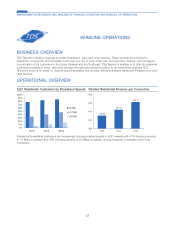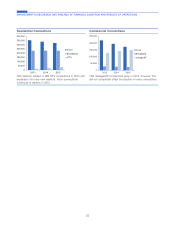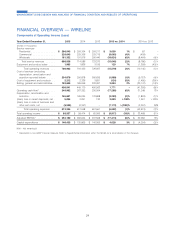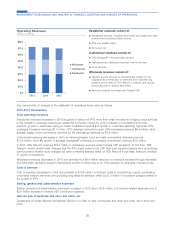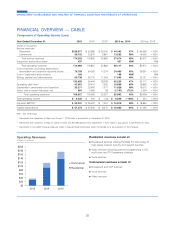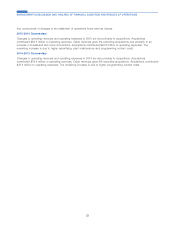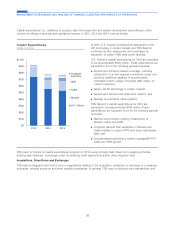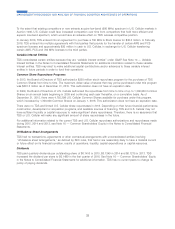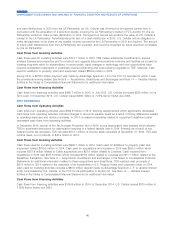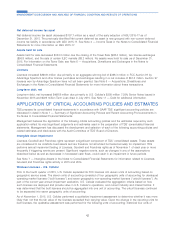US Cellular 2015 Annual Report Download - page 40
Download and view the complete annual report
Please find page 40 of the 2015 US Cellular annual report below. You can navigate through the pages in the report by either clicking on the pages listed below, or by using the keyword search tool below to find specific information within the annual report.
LIQUIDITY AND CAPITAL RESOURCES
Sources of Liquidity
TDS believes that existing cash and investment balances, funds available under its revolving credit facilities, and
expected cash flows from operating and investing activities provide liquidity for TDS to meet its normal day-to-day
operating needs and debt service requirements for the coming year.
TDS and its subsidiaries operate capital-intensive businesses. TDS has used internally-generated funds and also has
obtained substantial funds from external sources for general corporate purposes. In the past, TDS’ existing cash and
investment balances, funds available under its revolving credit facilities, funds from other financing sources, including a
term loan and other long-term debt, and cash flows from operating, investing and financing activities, including sales of
assets or businesses, provided sufficient liquidity and financial flexibility for TDS to meet its normal day-to-day operating
needs and debt service requirements, to finance the build-out and enhancement of markets and to fund acquisitions.
There is no assurance that this will be the case in the future. It may be necessary from time to time to increase the size
of the existing revolving credit facilities, to put in place new credit facilities, or to obtain other forms of financing in order
to fund potential expenditures. TDS’ liquidity would be adversely affected if, among other things, TDS is unable to obtain
short or long-term financing on acceptable terms, TDS makes spectrum license purchases in FCC auctions or from
other parties, the LA Partnership does not resume or reduces distributions compared to prior historical levels and/or ETC
and/or other regulatory support payments continue to decline. In addition, although sales of assets or businesses by
TDS have been an important source of liquidity for TDS in recent periods, TDS does not expect a similar level of such
sales in the future, which will reduce a source of liquidity for TDS. In recent years, TDS’ credit rating has declined to
sub-investment grade.
In certain recent periods, TDS has incurred negative free cash flow (defined as Cash flows from operating activities less
Cash used for additions to property, plant and equipment) and this will continue in the future if operating results do not
improve. TDS currently expects to have negative free cash flow in 2016. TDS may require substantial additional capital
for, among other uses, funding day-to-day operating needs, working capital, acquisitions of providers of wireless or
wireline telecommunications services, cable markets, IT services or other businesses, spectrum license or system
acquisitions, system development and network capacity expansion, debt service requirements, the repurchase of shares,
the payment of dividends, or making additional investments. There can be no assurance that sufficient funds will
continue to be available to TDS or its subsidiaries on terms or at prices acceptable to TDS. Insufficient cash flows from
operating activities, changes in its credit ratings, defaults of the terms of debt or credit agreements, uncertainty of
access to capital, deterioration in the capital markets, reduced regulatory capital at banks which in turn limits their ability
to borrow and lend, other changes in the performance of TDS or in market conditions or other factors could limit or
restrict the availability of financing on terms and prices acceptable to TDS, which could require TDS to reduce its
acquisition, capital expenditure and business development programs, reduce the acquisition of spectrum licenses,
and/or reduce or cease share repurchases and/or the payment of dividends. TDS cannot provide assurances that
circumstances that could have a material adverse effect on its liquidity or capital resources will not occur. Any of the
foregoing would have an adverse impact on TDS’ businesses, financial condition or results of operations.
Cash and Cash Equivalents
Cash and cash equivalents include cash and money market investments. The primary objective of TDS’ Cash and cash
equivalents investment activities is to preserve principal. Cash held by U.S. Cellular is for its operational needs and
acquisition, capital expenditure and business development programs. TDS does not have direct access to U.S. Cellular
cash unless U.S. Cellular pays a dividend on its common stock. U.S. Cellular has no current intention to pay a dividend
to its shareholders.
32
MANAGEMENT’S DISCUSSION AND ANALYSIS OF FINANCIAL CONDITION AND RESULTS OF OPERATIONS


